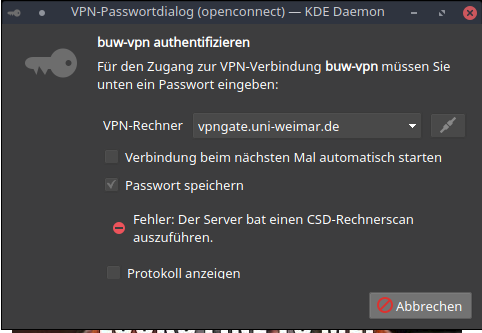Recently, I got a new project assignment that requires to connect permanently to the customer's network through VPN. They are using a so-called SSL VPN. As I am using since more than 5 years within my company's network I was quite curious about their solution and how it would actually be different from OpenVPN. Well, short version: It is a disguised version of OpenVPN.Unfortunately, the company only offers a client for Windows and Mac OS which shouldn't bother any Linux user after all. OpenVPN is part of every recent distribution and can be activated in a couple of minutes - both client as well as server (if necessary).
WatchGuard Firebox SSL - About dialog Borrowing some files from a Windows client installationInitially, I didn't know about the product, so therefore I went through the installation on Windows 8. No obstacles (and no restart despite installation of TAP device drivers!) here and the secured VPN channel was up and running in less than 2 minutes or so.
The v10.2.12 Mobile VPN with SSL client is integrated into the Fireware 10.2.12 appliance software. Mobile VPN with SSL users can choose to download the v10.2.12 client from the Firebox or download the v10.2.12 client from the WatchGuard web site if the remote users. What is WatchGuard Mobile VPN? WatchGurad Mobile VPN combined with SSL software is an application created by Macromedia that lets users gather information about connections, connect, exit or quit a client, and disconnect.

Watchguard Mobile Vpn With Ssl Downl…
Much appreciated from both parties - customer and me. Of course, this whole client package and my long year approved and stable installation ignited my interest to have a closer look at the WatchGuard client. Compared to the original OpenVPN client (okay, I have to admit this is years ago) this commercial product is smarter in terms of file locations during installation. You'll be able to access the configuration and key files below your roaming application data folder. To get there, simply enter '%AppData%WatchGuardMobile VPN'in your Windows/File Explorer and confirm with Enter/Return. This will display the following files. Application folder below user profile with configuration and certificate filesFrom there we are going to borrow four files, namely:.
ca.crt. client.crt. client.ovpn. client.pemand transfer them to the Linux system.You might also be able to isolate those four files from a Mac OS client.
Frankly, I'm just too lazy to run the WatchGuard client installation on a Mac mini only to find the folder location, and I'm going to describe why a little bit further down this article. I know that you can do that! Feedback in the comment section is appreciated. Update #1:One of the reader (zer0Sum) provided the path information to retrieve the necessary files on a Mac OS system: /Users/user/Library/WatchGuard/Mobile VPN/Thanks! Update #2:Retrieve the information directly from the WatchGuard Firebox as described in the next paragraph. Get the client configuration file from the WatchGuard FireboxDue to a replacement unit at my customer, I had to update all the certificates here on the client side, too.

And as I already changed my main machine I wouldn't like to install the Windows Client software on this computer. Actually, it is not necessary because the certificates can be downloaded from the appliance directly. Remote server and user authentication to establish the VPNPlease complete the test run and see whether all went well. You can disconnect pressing Ctrl+C. Simplify your life - use an authentication fileIn my case, I actually set up the OpenVPN client on my gateway/router.
Int cannot be dereferenced. Also, since this seems to be a school assignment, you might to read the page(s). The error message will provide a line number and other information that will make it easier (and therefore faster) to get a quality response. After reading the verbage on, please provide us with a posting of the error message. They hang out here on their free time, and asking for people to debug large programs is a lot to ask.
This establishes a VPN channel between my network and my client's network and allows me to switch machines easily without having the necessity to install the WatchGuard client on each and every machine. That's also very handy for my various virtualised Windows machines. Anyway, as the client configuration, key and certificate files are located on a headless system somewhere under the roof, it is mandatory to have an automatic connection to the remote site.For that you should first change the file extension '.ovpn' to '.conf' which is the default extension on Linux systems for OpenVPN, and then open the client configuration file in order to extend an existing line.
How to install a SSL Certificate for WatchGuard Firebox X Edge?Please follow these instructions to install your SSL certificate on WatchGuard Firebox X Edge:Note: Local certificates must include an unencrypted private key in the certificate file to operate correctly.1. Once you received your SSL certificate by e-mail, please copy and paste it into a text file and save the file with the.crt extension. (Include the tags -BEGIN CERTIFICATE- and -END CERTIFICATE-).2. From the System Status page on the Firebox X Edge, go to Administration Certificates.3.
Watchguard Firebox Ssl Client Download Free
Next to the certificate you want to add, click Import.4. Select the second radio button and click Browse to select the certificate file (from step 1).5. Click Import.